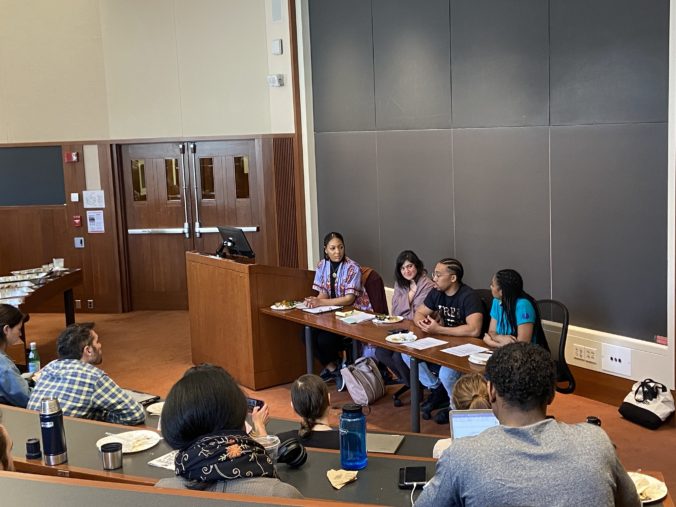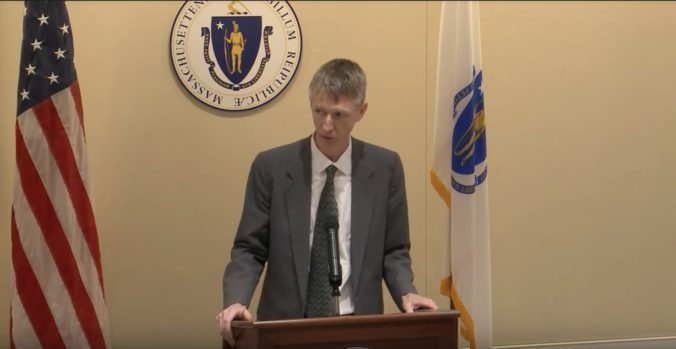By: Joel Thompson
The Boston Globe’s Spotlight team has published a follow-up story to its detailed account of the tactics used by Department of Correction officials and officers to “restore order” at Souza-Baranowski Correctional Center, in the weeks after an assault by multiple prisoners on correctional officers in one housing unit, on January 10, 2020. The prisoners involved in the January 10 assault were subdued by responding officers and were immediately transferred to other prisons. They were later indicted under state laws that provide enhanced sentences for assaulting correctional officers.
A prison-wide lockdown followed, and then a flurry of assaults by correctional officers on unrelated prisoners. This was not restoring order. Teams of officers attacked people who had nothing to do with the events of January 10. The two subjects of the first Spotlight article, Robert Silva-Prentice and Dionisio Paulino, have filed suit against prison officials for authorizing and carrying out the assault, and for issuing false disciplinary reports against them afterward as a way of covering up the brutality. The subject of the follow-up story, Isaias Torres-Vega, was also assaulted despite playing no role in the January 10 assault.
They were not alone. As the first Spotlight article describes, prisoners at SBCC contacted Prisoners’ Legal Services with 118 reports of excessive force by officers in the weeks after January 10, 2020, a dramatic increase from the 4 reports made over the same period in 2019. Officers who assaulted these people frequently issued them disciplinary reports, accusing them of assaulting staff. This wave of violence, given its timing and location, bears all the marks of collective punishment.
Could abuse of this magnitude come and go with no fallout for its participants? The latest Spotlight piece highlights the role of one correctional officer, who may or may not have been disciplined for excessive force. It is hard to say, since information concerning these assaults and the outcome of any investigation thereof is not readily forthcoming. The reticence of prison officials goes well beyond this one officer’s actions. Consider the fact that video footage of the cell extraction and canine assault on Mr. Silva-Prentice and Mr. Paulino did not reach the public until August of 2021, after prison officials sought and failed to obtain a gag order preventing its disclosure.
A prison system limiting access to information is nothing new. Prisons are the least transparent of our taxpayer-funded endeavors. For decades, judges and lawmakers were told – and largely accepted – that it must be this way, that any hint of daylight will jeopardize security. For decades, prisoners and their loved ones have been the victims of this opacity. (Note, however, that this opacity is selective. The same officials who fought disclosure of officer brutality were, on January 10, 2020, breathless in their rush to disseminate video footage of the assault on officers. It was available in time for the evening news. There is no principled stance here, just a belief that you should only see what they want you to see.)
People sentenced to prison are told that they are being held accountable for their wrongs. They are told that actions have consequences. But in prison, they find that only some people’s actions have consequences, and accountability is not a two-way street. Nowhere was that more evident than at SBCC after January 10, 2020.
Over the years, PLAP’s students have defended hundreds of incarcerated clients against prison disciplinary reports. The allegations run the gamut from minor infractions to violent or destructive acts. The case of the prisoner who is beaten by a team of officers, then charged with assaulting them, is nothing new to us. What was new in 2020 was the volume of such cases, which was unprecedented. While unable to represent all of those requesting help, PLAP students defended over 20 individuals who were issued nearly 40 disciplinary reports at SBCC in the weeks following January 10, 2020. Several of these disciplinary reports alleged that the client assaulted correctional officers, an accusation officers made after assaulting the client. Those same clients were issued additional disciplinary reports, alleging other violations. These cases took months to resolve, with PLAP students operating remotely because of the COVID pandemic.
Some notable similarities emerged among those clients who were assaulted, then accused of assaulting staff:
- They were not involved with the January 10 assault on officers. That fact bears repeating. It was not disputed by prison officials. People across the prison, with no involvement in the events of January 10, were summarily attacked. This was not the outraged response of a few employees in the heat of the moment; it was a calculated response, coordinated and carried out in the days and weeks that followed.
- They were Black and Brown. Like the men profiled in the Spotlight articles, PLAP’s clients who were assaulted and then accused of assaulting staff were Black and Brown people. This fact is predictable, with disproportionate minority representation in the state prison population generally and even more so at maximum-security SBCC. But it remains notable. These assaults were indiscriminate, but they were not completely indiscriminate.
- They posed no threat. There are occasions when a confrontation arises out of a dispute between an incarcerated person and staff, in a housing unit or other large area with other people around and a potential for volatility, and officers use force to end it. That was not the situation with any of these cases. PLAP’s clients were alone or with a cellmate, bothering no one. Officers entered and assaulted a defenseless target. Clients were struck, sprayed with OC gas, shot with pepperballs, and attacked with Tasers. Officers continued to assault people even after they were restrained. Two clients had dreadlocks pulled out or cut off while they were handcuffed.
- Many of them are now out of prison. Given that SBCC is a maximum-security prison, one could be forgiven for assuming that its occupants are serving the longest sentences. That is not the case. At least one-third of PLAP’s clients from SBCC finished their sentences and were released in the eighteen months after January 2020. People who were assaulted, as punishment for actions they played no part in, were soon thereafter discharged from DOC custody. The Department’s Mission Statement includes preparing people “for successful re-entry into the community.” This is an interesting reentry plan, to say the least. What we do to people in prison does not stay in prison. We may hope that when a person’s prison sentence ends, he returns to the community with a new understanding of justice. He probably does, but it is not the understanding we would like him to have.
In defending their clients against these assault allegations, PLAP students also discovered common features in the way that these assaults were carried out and investigated:
- An evidence-free selection of targets. Staff assaults often took the form of cell extractions, approved by senior officials based on nebulous allegations of past or predicted future wrongdoing. No specific details about these past or future wrongs was forthcoming, nor was the basis for these allegations disclosed. Officers carrying out the assaults denied being advised of the reasons; the word simply came from above that the prisoner in question was to be moved.
- Supercharged teams wielding every piece of equipment – except the camera. Teams were assembled that included eight or more officers, with some officers donning protective gear while others carried various weapons, including pepperball guns, Tasers, OC spray, and attack dogs. These teams had time to arm themselves and bring every last piece of equipment, except for the handheld video camera that is supposed to document a use of force. The camera was left behind every time, and officer teams assaulted our clients in spaces out of view of the building’s surveillance cameras. Participating officers uniformly testified that the use of force was “spontaneous” and thus they could not have brought the handheld video camera, a laughable notion given the careful orchestration of these actions, but one which was uniformly endorsed by prison officials.
- An opportunity to get the story straight. Officers “debriefed” together after the assault, before writing their individual reports recounting what happened. They could also watch the surveillance video footage from the area – allowing them to learn what could and could not be seen on video – before writing their reports. The latter practice violates the DOC’s own regulations, but according to participating officers, it was condoned if not expected by supervisors.
- A concerted lack of interest in other sources of information. Internal investigations often followed these assaults, but prisoners in the vicinity of the assault were not asked what they heard or saw. All that was gathered was the coordinated account of the participating officers. When departmental investigators are looking into alleged misconduct by prisoners, they are more than willing to interview other incarcerated people. The interest level in what prisoners have to say drops precipitously when investigating allegations of staff misconduct.
- Withholding of internal reports. When internal investigations into these assaults were conducted, the resulting reports were more often than not withheld from PLAP students and their clients. Use of force reports, required by DOC regulations in each of these episodes, were also frequently withheld, save for a one-sentence boilerplate cover memo announcing that the review was complete and the use of force was compliant with policy.
This is not a truth-seeking process. It is a process designed to produce the desired outcome. Prison officials control the whole environment; no bystander is walking by with a smartphone. Prison officials decide whether evidence will exist (such as handheld video recordings), whether evidence that exists will be gathered (like witness accounts), and whether evidence will be reliable (including whether officers will be permitted to confer and review video before writing their reports). They are the only ones reviewing that evidence. When a client is found guilty and punished after a disciplinary hearing, the decision often states that the sanction “serves to educate the inmate as to the consequences of his actions.” Our clients are educated, to be sure. They learn that the difference between right and wrong depends not on what you have done, but on which uniform you are wearing.
A self-policing prison system harms the people in custody, undermining their physical safety and any sense that there is legitimacy in government institutions. (It also harms those prison employees who observe the rules, but who know that there will be no consequences for those others who do not.) In 2020, the Governor endorsed the DOC’s self-policing capabilities, and the results are predictable: no results of any investigation into the collective punishment of SBCC prisoners, no announced disciplinary measures taken against staff, no announced policy changes designed to prevent future abuses. The Department, in its Vision Statement, aims to “eliminate Violence, Victimization, and Recidivism,” but it can make no valid claim to this vision so long as it engages in the very actions that it says it wants to eliminate.



